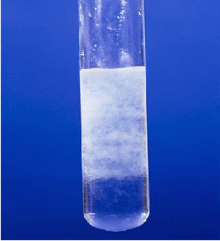


| |
| Names | |
|---|---|
| IUPAC name
Beryllium hydroxide | |
Other names
| |
| Identifiers | |
3D model (JSmol) |
|
| ChEBI | |
| ChemSpider |
|
| ECHA InfoCard | 100.033.048 |
| EC Number |
|
| 1024 | |
| MeSH | Beryllium+hydroxide |
PubChem CID |
|
| RTECS number |
|
| UNII | |
CompTox Dashboard (EPA) |
|
| |
| |
| Properties | |
| BeH2O2 | |
| Molar mass | 43.026 g·mol−1 |
| Appearance | Vivid white, opaque crystals |
| Density | 1.92 g cm−3[1] |
| Melting point | (decomposes) |
| 0.0000023965 g/L | |
Solubility product (Ksp) |
6.92×10−22[2] |
| Acidity (pKa) | 3.7[3] |
| Structure | |
| Linear | |
| Thermochemistry | |
Heat capacity (C) |
1.443 J K−1 |
Std molar |
47 J·mol−1·K−1[4] |
Std enthalpy of |
-904 kJ mol−1[4] |
Gibbs free energy (ΔfG⦵) |
-818 kJ/mol |
| Hazards | |
| Occupational safety and health (OHS/OSH): | |
Main hazards |
Carcinogenic |
| GHS labelling: | |
   [5] [5]
| |
| Danger | |
| NFPA 704 (fire diamond) | |
| Lethal dose or concentration (LD, LC): | |
LD50 (median dose) |
4 mg kg−1 (intravenous, rat) |
| NIOSH (US health exposure limits): | |
PEL (Permissible) |
TWA 0.002 mg/m3 C 0.005 mg/m3 (30 minutes), with a maximum peak of 0.025 mg/m3 (as Be)[6] |
REL (Recommended) |
Ca C 0.0005 mg/m3 (as Be)[6] |
IDLH (Immediate danger) |
Ca [4 mg/m3 (as Be)][6] |
| Related compounds | |
Related compounds |
Aluminium oxide |
Except where otherwise noted, data are given for materials in their standard state (at 25 °C [77 °F], 100 kPa). | |
Beryllium hydroxide, Be(OH)2, is an amphoteric hydroxide, dissolving in both acids and alkalis. Industrially, it is produced as a by-product in the extraction of beryllium metal from the ores beryl and bertrandite.[7] The natural pure beryllium hydroxide is rare (in form of the mineral behoite, orthorhombic) or very rare (clinobehoite, monoclinic).[8][9] When alkali is added to beryllium salt solutions the α-form (a gel) is formed. If this left to stand or boiled, the rhombic β-form precipitates.[10] This has the same structure as zinc hydroxide, Zn(OH)2, with tetrahedral beryllium centers.[11]
Beryllium hydroxide is difficult to dissolve in water. With alkalis it dissolves to form the tetrahydroxoberyllate (also known as tetrahydroxidoberyllate) anion, [Be(OH)4]2−.[12] With sodium hydroxide solution:
With acids, beryllium salts are formed.[12] For example, with sulfuric acid, H2SO4, beryllium sulfate is formed:
Beryllium hydroxide dehydrates at 400 °C to form the soluble white powder, beryllium oxide:[12]
Further heating at higher temperature produces acid insoluble BeO.[12]
|
| |
|---|---|
| Beryllium(I) |
|
| Beryllium(II) |
|
|
| ||||||||||||||||||||||||||||||||||||||||||||||||||||||||||||||||||||||||||||||||||||||||||||||||||||||||||||||||||||||||||||||||||||||||||||||||||||||||||||||||||||
|---|---|---|---|---|---|---|---|---|---|---|---|---|---|---|---|---|---|---|---|---|---|---|---|---|---|---|---|---|---|---|---|---|---|---|---|---|---|---|---|---|---|---|---|---|---|---|---|---|---|---|---|---|---|---|---|---|---|---|---|---|---|---|---|---|---|---|---|---|---|---|---|---|---|---|---|---|---|---|---|---|---|---|---|---|---|---|---|---|---|---|---|---|---|---|---|---|---|---|---|---|---|---|---|---|---|---|---|---|---|---|---|---|---|---|---|---|---|---|---|---|---|---|---|---|---|---|---|---|---|---|---|---|---|---|---|---|---|---|---|---|---|---|---|---|---|---|---|---|---|---|---|---|---|---|---|---|---|---|---|---|---|---|---|---|
| ||||||||||||||||||||||||||||||||||||||||||||||||||||||||||||||||||||||||||||||||||||||||||||||||||||||||||||||||||||||||||||||||||||||||||||||||||||||||||||||||||||